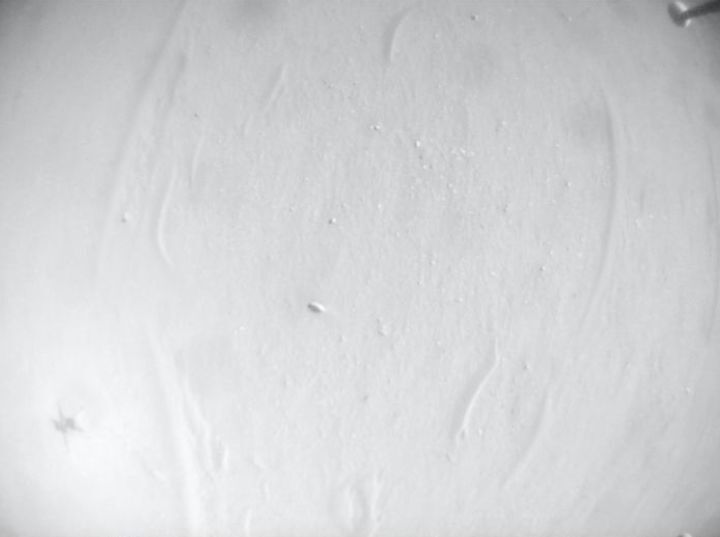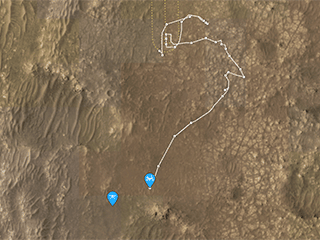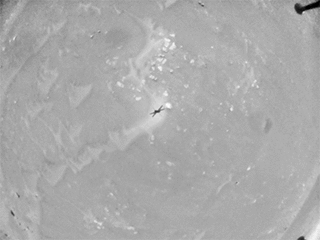A small piece of foreign object debris (FOD) was seen in footage from the Mars helicopter’s navigation camera (Navcam) for a portion of its 33rd flight. This FOD was not visible in Navcam footage from the previous flight (32). The FOD is seen in Flight 33 Navcam imagery from the earliest frames to approximately halfway through the video, when it fell from the leg and drifted back to the Mars surface. All telemetry from the flight and a post-flight search and transfer are nominal and show no indication of vehicle damage. The Ingenuity and Perseverance Mars 2020 teams are working to discern the source of the debris.
+++
Where is the Mars Helicopter?
+++
Quelle: NASA
----
Update: 7.10.2022
.
Perseverance Mars rover picks up 'lucky' 13th rock sample for return to Earth
The sample, and dozens more like it, could come to Earth as early as 2033.

The NASA Perseverance rover collects its 13th Red Planet sample in October 2022. (Image credit: NASA/JPL-Caltech)
NASA's Perseverance rover has snagged another Red Planet sample for eventual shipment to Earth.
Perseverance, which is exploring Jezero Crater on Mars, collected its 13th drilled-out rock core in recent days, according to NASA's Jet Propulsion Laboratory (JPL) in Southern California, which manages the car-sized robot's mission.
"A beautiful site for collecting lucky rock core #13! Currently nerding out over this fine-grained sample, and aiming to get another like it from this area. #SamplingMars," JPL officials said via Twitter(opens in new tab) on Tuesday (Oct. 4), in a post that also featured photos of the newly collected sample.
As Perseverance grows its cache of Red Planet rocks, rover team members are preparing for an ambitious future phase of the mission: sending these samples to Earth, perhaps as soon as 2033. The sample-return campaign, a joint effort of NASA and the European Space Agency (ESA), offers a good chance to hunt for signs of ancient Mars life, as Jezero Crater hosted a big lake and a river delta billions of years ago.
The nominal plan is for Perseverance to deliver the rock cores to a NASA sample-return lander, which will also carry a small rocket. The rocket will launch the samples to Mars orbit, where they'll meet up with an ESA-provided Earth return orbiter. (All of this hardware save Perseverance is still in development.)
Perseverance is collecting two samples from each rock that it drills, however. The rover will keep one set of samples on board and cache the other set in one or more "depots" on Jezero's floor.
The depots represent a backup option, in case Perseverance isn't able to haul the samples to the lander. The lander will also carry two small "fetch" helicopters, which are designed to bring the sample tubes back from the depot(s) one by one if need be.
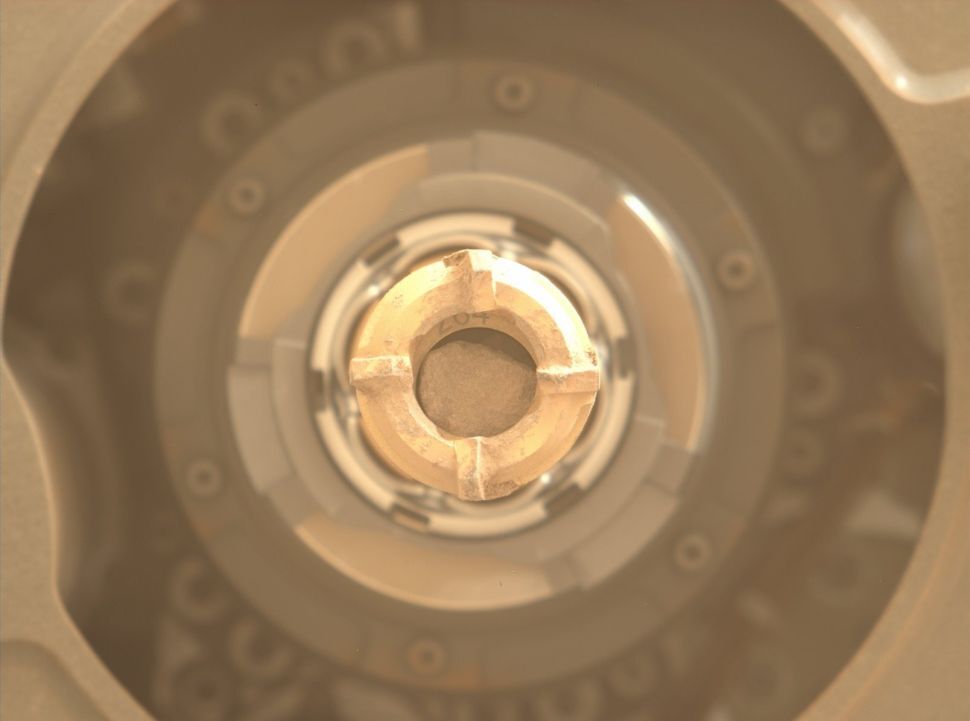
The 13th sample picked up by NASA's Perseverance rover sits safely in the collection system. (Image credit: NASA/JPL-Caltech)
Simultaneously, NASA is pushing the Ingenuity helicopter that accompanied Perseverance to the surface in February 2021 well beyond its design lifetime, and finding that the helicopter is doing well — presenting an opportunity for future drone development. Indeed, Ingenuity's success is already shaping NASA's Mars exploration plans; the two fetch helicopters that will launch with the sample-return lander, for example, will be very similar to Ingenuity.
Ingenuity was originally rated for just five flights and is now looking to break that mark by at least sevenfold. Its most recent and 33rd flight took place in late September; although it landed safely, officials are examining a piece of debristhat fell away harmlessly from one of the legs during the flight.
Quelle: SC
----
Update: 2.11.2022
.
Perseverance to establish sample cache for later return to Earth
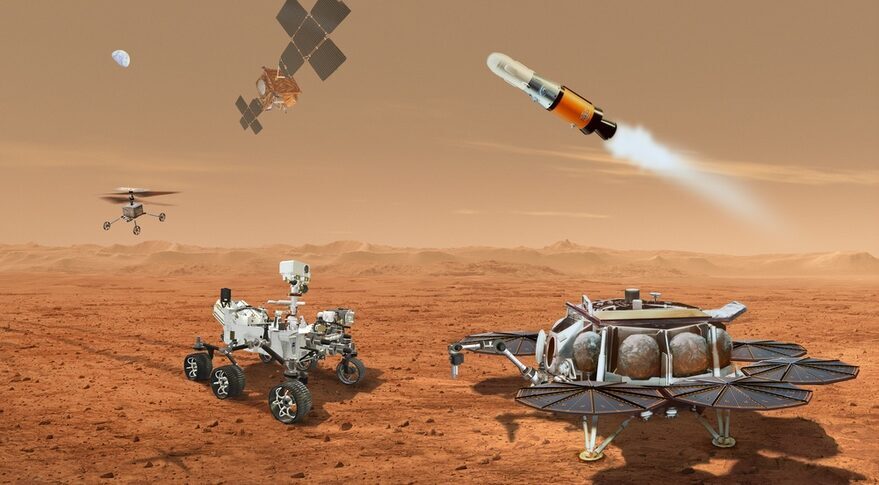
The sample cache will be a backup should Perseverance be unable to return samples to a future lander. Helicopters based on Ingenuity will bring samples from the cache to the lander. Credit: NASA
WASHINGTON — NASA and the European Space Agency have selected a location on Mars to cache samples collected by the Perseverance rover, one step in the overall process of returning those samples to Earth.
NASA announced Oct. 28 that the agencies agreed to deposit some of the 14 samples collected by Perseverance to date at a location dubbed “Three Forks” in Jezero Crater, near the remnants of an ancient river delta that once flowed into the crater. Those samples, encased in metallic tubes, will be picked up for return to Earth by later missions.
“NASA and ESA have reviewed the proposed site and the Mars samples that will be deployed for this cache as soon as next month. When that first tube is positioned on the surface, it will be a historic moment in space exploration,” Thomas Zurbuchen, NASA associate administrator for science, said in a statement.
The sample cache is part of a revised strategy for the overall Mars Sample Return campaign announced in July. That strategy does away with a European “fetch” rover that was to pick up samples cached by Perseverance. Instead, it will rely on Perseverance as the primary means of returning samples to a future lander, which will then launch them into orbit to be picked up by an ESA orbiter for return to Earth.
This cache serves as a backup should Perseverance be unable to return to the lander. That lander will have two small helicopters, based on the Ingenuity helicopter accompanying Perseverance, that will fly to the cache, collect sample tubes, and return them to the lander.
“The depot is risk mitigation if the rover does not make the long journey” to the lander, said Francois Spoto, the Mars exploration group leader at ESA, during a presentation about Mars Sample Return at the International Astronautical Congress (IAC) in Paris Sept. 20.
Perseverance had been taking duplicate samples from each site so that one set can be kept on Perseverance and the other deposited in the cache. “Once we’ve done that, we’ll stop double sampling and continue to build the cache to be retained on Perseverance,” said Jeff Gramling, director of the Mars Sample Return program at NASA, at the IAC presentation.
In the announcement of the sample cache plans, NASA also said that on Oct. 1 the Mars Sample Return program entered Phase B, which covers preliminary design work and completion of key technologies needed for the future lander mission.
Both NASA and ESA officials have remained reticent to discuss the costs of the revised Mars Sample Return architecture, including any cost savings from deleting the fetch rover and a second lander that would have delivered it. NASA generally does not provide formal cost and schedule estimates for a mission until it is ready to enter Phase C, where the design is finalized and fabrication of components begins.
Asked about the costs of Mars Sample Return during their IAC presentation, neither Gramling nor Spoto would give a specific cost or range of costs. However, they did estimate that ESA’s share would be 15-20% of the overall cost.
Quelle: SN
----
Update: 19.11.2022
.
NASA’s Perseverance Rover Investigates Intriguing Martian Bedrock

This image of “Yori Pass” was taken by a Hazcam imager aboard NASA’s Perseverance Mars rover on Nov. 5, 2022.
Credit: NASA/JPL-Caltech
Exploring a sediment-rich location in this Mars delta offers tantalizing opportunities for the six-wheeler’s science team.
NASA’s Perseverance Mars rover has begun exploring an area the science team calls “Yori Pass” near the base of Jezero Crater’s ancient river delta. They’ve been eager to explore the region for several months after spotting a rock similar to one Perseverance collected samples from in July.
The feature is so tantalizing to the scientists because it is sandstone, which is composed of fine grains that have been carried from elsewhere by water before settling and forming stone. Perseverance’s samples are central to the first step in the NASA-ESA (European Space Agency) Mars Sample Return campaign, which began when the rover cached its first cored rock in September 2021.
This short animation features key moments of NASA and ESA’s Mars Sample Return campaign, from landing on Mars and securing the sample tubes to launching them off the surface and ferrying them back to Earth.
“We often prioritize study of fine-grained sedimentary rocks like this one in our search for organics and potential biosignatures,” said Katie Stack Morgan, Perseverance deputy project scientist at NASA’s Jet Propulsion Laboratory in Southern California. “What’s especially interesting about the Yori Pass outcrop is that it is laterally equivalent with ‘Hogwallow Flats,’ where we found very fine-grained sedimentary rocks. That means that the rock bed is located at the same elevation as Hogwallow, and has a large, traceable footprint visible on the surface.”
The hunt at Jezero Crater for biosignatures (any characteristic, element, molecule, substance, or feature that can serve as evidence for ancient life) is one of the Perseverance rover’s four science objectives. Along with its 14 rock-core samples, the rover has collected one atmospheric sample and three witness tubes, all of which are stored in the rover’s belly.
After it collects a sample from Yori Pass, Perseverance will drive 745 feet (227 meters) southeast to a mega sand ripple. Located in the middle of a small dune field, the ripple – called “Observation Mountain” by the science team – will be where the rover collects its first samples of regolith, or crushed rock and dust.
Quelle: NASANASA Invites Public Comment on Plans for Mars Sample Return Campaign
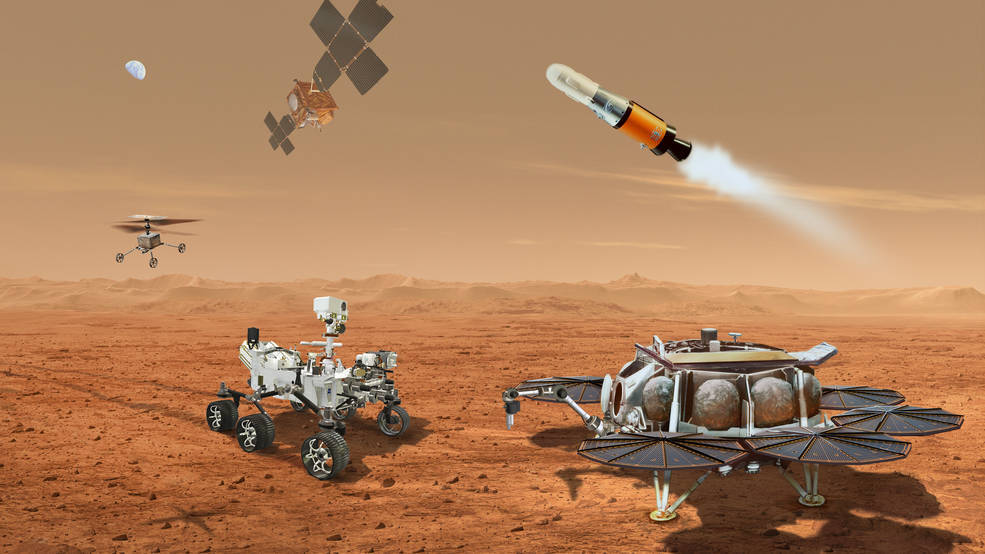
Editor's Note: This release was updated on Nov. 23, 2022 to further clarify the virtual meetings link will not be active until about 15 minutes before the meetings.
NASA is seeking public comments on a draft environmental impact statement for the agency’s Mars Sample Return (MSR) campaign. Comments are due by Monday, Dec. 19.
Comments can be submitted online, through the mail, or through participation in a series of virtual and in-person meetings. Advanced registration for meeting options, including in-person meetings in Utah, is not required.
Two virtual meetings to discuss the Draft Programmatic Environmental Impact Statement for the campaign will take place on Wednesday, Nov. 30. The first begins at 1 p.m. MST, followed by a second opportunity at 6 p.m. MST. The WebEx link will be activated about 15 minutes before the events begin and will display “room cannot be found” until it is activated. Once live, it will include an option for real-time automated closed captioning. To access audio-only dial 510-210-8882, and use meeting number 901-525-785. Participate online at either time by joining the following link:
The in-person meetings will be held at 6 p.m. MST on Tuesday, Dec. 6, at the Wendover Community Center, 112 E Moriah Avenue, Wendover, Utah, and on Wednesday, Dec. 7, at the Clark Planetarium, 110 S 400 W, Salt Lake City, Utah.
All public meetings will include a 15-minute presentation on the purpose of the meetings, the MSR campaign project schedule, opportunities for public involvement, a summary of the proposed action and alternatives, discussion of potential environmental impacts from the proposed action, and an overview of the programmatic approach to National Environmental Policy Act compliance in general, and NASA’s proposed action specifically. The in-person meetings also will include a 45-minute open house before the official public comment portion of the meeting.
Subject matter experts will be available on-site during the open house to answer questions from the public, and to discuss informational posters and distribute related materials about the draft statement and the proposed Mars Sample Return campaign. These materials are also available online.
NASA and ESA (European Space Agency) are planning to use robotic Mars orbiter and lander missions launched in 2027 and 2028 to retrieve samples of rocks and atmosphere being gathered by NASA’s Perseverance rover and return them to Earth. The samples of Mars material, securely isolated inside a robust Earth Entry System using a layered “container within a container” approach, could be brought to Earth in the early 2030s, landing notionally at the Utah Test and Training Range operated by the U.S. Air Force. The Earth Entry System would then be transported to a specialized MSR sample receiving facility.
NASA will consider all comments received during the PEIS public comment period in the subsequent development of the MSR Final Environmental Impact Statement.
In addition to receiving comments during the public meetings, comments may be sent to NASA in the following ways:
- Federal e-Rulemaking Portal: Follow the online instructions for submitting comments and include Docket No. NASA-2022-0002. Please note that NASA will post all comments online without changes, including any personal information provided.
- By mail to Steve Slaten, NASA Jet Propulsion Laboratory, 4800 Oak Grove Drive, M/S: 180-801, Pasadena, CA 91109–8099
Additional information on the agency’s National Environmental Policy Act process and the proposed campaign is available online.
Quelle: NASA
----
Update: 27.11.2022
.
Mars helicopter Ingenuity aces 1st flight after major software update
The update will make Ingenuity more capable in hilly terrain.

An image of the Mars surface taken by the Ingenuity helicopter's navigation camera during a flight testing out a new software system on Nov. 22, 2022. (Image credit: NASA)
NASA's Mars helicopter Ingenuity has performed its shortest-ever flight, the first after a major software update that will allow the little chopper to land more safely and navigate over rugged terrain.
Ingenuity's 34th flight, which took place on Tuesday (Nov. 22), lasted only 18 seconds and saw the helicopter briefly hover after takeoff above Mars' surface before landing just 16 feet (5 meters) away from its starting point. The flight, the first since Sept. 29, was the first try-out of a new software system that was beamed to Ingenuity from Earth to improve its ability to operate in the rugged terrain that its parent Perseverance rover is currently exploring.
Ingenuity is an extremely successful technology demonstration, but it was built to navigate in smooth terrain, such as Wright Brothers Field, where it was first deployed in April 2021. The helicopter has been nailing one flight after another, prompting its ground control teams to dare to begin sending the flying robot into more complicated landscapes.
These more daring flights required the Ingenuity team to search for level airfields that are free of rocks that could damage the helicopter during landing. Because Jezero Crater, which the helicopter and Perseverance are exploring, is rather rocky, those flat, safe airfields have been hard to find. The new software will use Ingenuity's downward-facing camera to detect risky objects before landing and steer Ingenuity to avoid them, allowing the chopper to use smaller airfields.
"While in flight, Ingenuity will identify the safest visible landing site," the Ingenuity team said in a statement(opens in new tab). "When preparing to land, Ingenuity will then divert over to this selected site."
The software will also make Ingenuity more confident in flight. Since the helicopter was designed to fly over flat fields, its cameras previously could get confused by seeing a hilly landscape underneath. The old software would think the helicopter was veering, which would make it actually veer while in flight in a misguided attempt to stabilize its course.
"Over long flights, navigation errors caused by rough terrain must be accounted for, requiring the team to select large airfields," the Ingenuity team said in the statement. "This new software update corrects this flat-ground assumption by using digital elevation maps of Jezero Crater to help the navigation software distinguish between changes in terrain and vehicle movement."
With the new software, Ingenuity will be able to scout a wider range of terrain types for Perseverance to explore in detail.
"We’re all excited to see where this update will allow us to take Ingenuity’s journey next!" the team wrote.
Quelle: SC
----
Update: 8.12.2022
.
Mars helicopter Ingenuity soars higher than ever on 35th Red Planet flight
The little chopper got 46 feet (14 meters) above Mars' red dirt on Saturday (Dec. 3).

NASA's Ingenuity helicopter keeps raising the bar for Red Planet flight.
The 4-pound (1.8 kilograms) Ingenuity soared 46 feet (14 meters) above Mars' red dirt on Saturday (Dec. 3), setting a new altitude record on its 35th off-Earth flight.
The little chopper's previous record was 39 feet (12 m), achieved on three previous Mars flights. (You can get a rundown of all 35 Ingenuity sorties in the mission's flight log(opens in new tab).)
Ingenuity landed with NASA's Perseverance rover on the floor of Jezero Crater in February 2021. The helicopter soon deployed from the rover's belly and embarked on a campaign to show that powered flight is possible in the thin Mars atmosphere.
That initial technology-demonstrating phase lasted less than a month and consisted of just five sorties. But NASA soon granted Ingenuity a mission extension, keeping the rotorcraft flying. Its current objectives center on pushing the envelope of Red Planet flight and performing reconnaissance for Perseverance.
The rover is searching for signs of ancient Mars life on the floor of the 28-mile-wide (45 kilometers) Jezero, which hosted a lake and a river delta billions of years ago. Perseverance is also collecting and caching a series of samples, which a joint NASA-European Space Agency campaign will return to Earth, perhaps as early as 2033.
Saturday's flight was the first for Ingenuity since Nov. 22 and just the second it has performed since a major software update. That update, which took several weeks to install, "provides Ingenuity two major new capabilities: hazard avoidance when landing and the use of digital elevation maps to help navigate," mission team members wrote in a blog post late last month(opens in new tab).
Ingenuity covered about 49 feet (15 m) of horizontal distance on Saturday's flight, which lasted 52 seconds. The helicopter has now traveled a total of 24,302 feet (7,407 m) and stayed aloft for 59.9 minutes on its 35 Mars sorties, according to the mission flight log.
Quelle: SC
----
Update: 9.12.2022
.
Perseverance's First 2 Regolith Samples
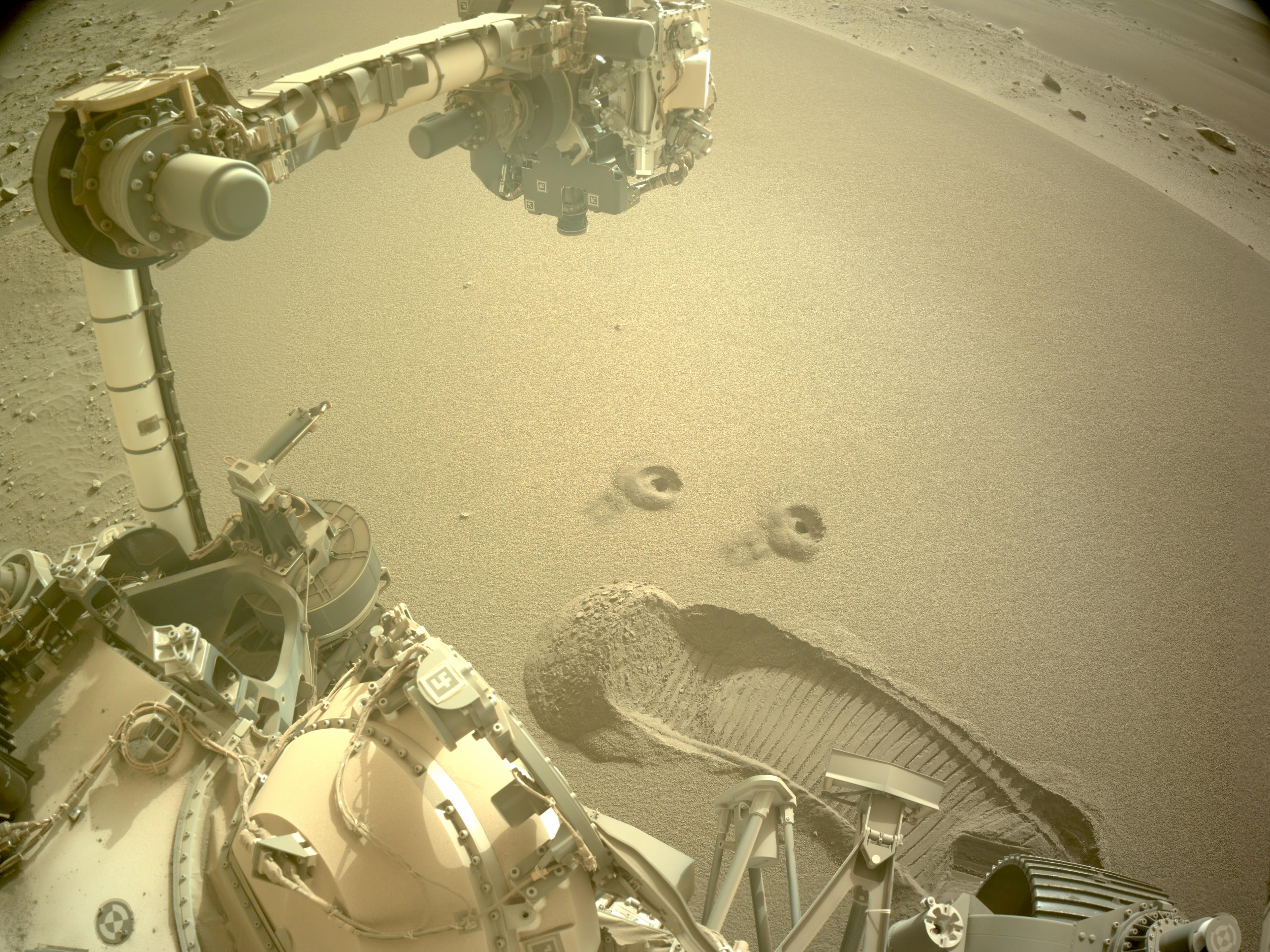
NASA's Perseverance Mars rover snagged two samples of regolith – broken rock and dust – on Dec. 2 and 6, 2022. This set of images, taken by the rover's left navigation camera, shows Perseverance's robotic arm over the two holes left after the samples were collected.
The samples were taken in Mars' Jezero Crater from a pile of wind-blown sand and dust called a "mega-ripple" – a feature similar to but smaller than a dune. One of the two regolith samples will be considered for deposit on the Martian surface this month as part of the Mars Sample Return campaign.
Studying regolith with powerful lab equipment back on Earth will allow scientists to better understand the processes that have shaped the surface of Mars and help engineers design future missions as well as equipment used by future Martian astronauts.
A key objective for Perseverance's mission on Mars is astrobiology, including the search for signs of ancient microbial life. The rover will characterize the planet's geology and past climate, pave the way for human exploration of the Red Planet, and be the first mission to collect and cache Martian rock and regolith.
Subsequent NASA missions, in cooperation with ESA (European Space Agency), would send spacecraft to Mars to collect these sealed samples from the surface and return them to Earth for in-depth analysis.
The Mars 2020 Perseverance mission is part of NASA's Moon to Mars exploration approach, which includes Artemis missions to the Moon that will help prepare for human exploration of the Red Planet.
NASA's Jet Propulsion Laboratory, which is managed for the agency by Caltech in Pasadena, California, built and manages operations of the Perseverance rover.
Quelle: NASA





